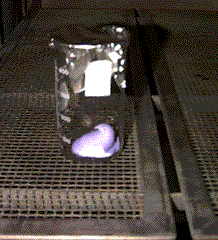|
|
Hot Peeps |
|
|
|
Hot Peeps |
|
Introduction:
It is common knowledge that Peeps, while abundant in the Spring, become sparse by early summer.
Many have speculated that this dramatic population reduction is a natural result of complex predator/prey relationships. Peep populations appear to swell up until the bizarre convergence of 50% off sales at grocery stores and pharmacies around the world. Dedicated teams of scientists, engineers, and astrologists have yet to explain why this always happens on a Monday.
After extensive government-funded exploration on the beaches of Florida, Maui, and the Bahamas resulted in severe burns to our research team, we learned a new appreciation for sunblock. Recognizing that few Peeps are seen traveling with anything higher than SPF4, we began to suspect that Peeps might have an adverse reaction to heat.
Methods:
Utilizing the well-established scientific axiom that a little exposure over a long time is about the same as a lot of exposure over a little time (see related works on saccharin, X-rays, and FD&C Red number 2) , we decided that the best tool for investigating heat would be the autoclave across the hall.
What is an autoclave? Imagine a refrigerator-sized pressure cooker, capable of killing any living tissues, bacteria, or fungi. This is the tool we utilized.
Our subject was exposed to 10 atmospheres of pressure at 350 degrees Fahrenheit for 15 minutes.
Results:
As suspected, our Peep subject did show adverse reactions to the experimental conditions, including, but not limited to headaches, poor eyesite, increased density, and general gooeyness.

As shown above in our state-of-the-art time-lapse photography sequence, by the end of our test sequence the Peep has returned to a more elemental state known commonly as " Fluff" or " Marshmallow Fluff".
[The photo sequence will repeat automatically after a short pause]
Conclusion
We all know that the atmosphere of Venus consists in large part of ammonia. Early unmanned Soviet exploration of Venus failed to uncover signs of Peep presence, despite all speculation to the contrary. We know, however, from our solubility tests that the presence of an ammonia atmosphere alone would not exclude feasible colonization of Venus by ancient space-travelling Peeps.
Furthermore, observations of Peep biochemistry indicate a molecular structure unlike any other terrestrial organisms yet encountered, leading to the obvious conclusion that Peeps are not of this world (Mulder & Scully, et. al. 1996). In addition, while early evolutionary biologists have suggested that the lack of variation in the peep population was due to an ancient bottleneck event, we suggest the more likely scenario of the founder effect phenomenon during terrestrial colonization.
Thus we arrive at our paradigm-shattering conclusion that billions of Peep spores were scattered throughout the galaxy millions of years ago, landing on all planets throughout our solar system and beyond. While these courageous pioneers of Peepdom fared the ammonia atmosphere of Venus without any ill effects, the temperature must have proved to much for even the heartiest marshmallow chicks.